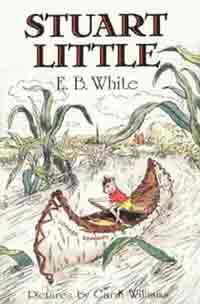Stuart Little

The Story Behind Hollywood's Big Mouse
by Holly Hartman |
 |
AFTER MORE THAN HALF A CENTURY as a quietly beloved literary figure, Stuart Little has become a cash cow of a mouse—the grinning, computer-generated star of a $90 million movie and the subject of seven new books, as well as a line of products that includes plush toys, games, and a mouse-shaped backpack.
Some think the cinematic Stuart was modeled more after Michael J. Fox, who provides the character's screen voice, than the little hero who had what creator E. B. White called the "shy, pleasant manner of a mouse."
Dreaming It Up
THE CHARACTER of Stuart Little first appeared in a dream to famed essayist E. B. White in the 1920s. White wrote a few episodes about this boy who looked like a mouse and then tucked them away in a drawer, thinking he might one day share them with his nieces and nephews. Some twenty years later he expanded and collected the stories as Stuart Little, published in 1945. It was White's first children's book.
It was also the first book illustrated by renowned artist Garth Williams. White's editor complained that "it is terribly difficult to draw ATTRACTIVE mice" and went through no less than eight illustrators before signing up Williams, a prize-winning sculptor.
White and Williams discussed every detail of the illustrations. White made suggestions and comments, in one letter expressing delight that Williams had drawn shoes that are "just right for a mouse's feet." White himself found a model for Harriet Ames (a character who does not appear in the movie) in a clipping from a Sears catalogue.
Not for Tots?
AT THE TIME it was published some critics expressed concern that Stuart Little was "bad for children"—the story too open-ended, the main character too independent. Meanwhile, newspapers reviewed the book almost as though it were a work of fiction for adults.
Many do think Stuart Little is best understood by older readers. White said it is about "the continuing journey that everybody takes-—in search of what is perfect and unattainable. This is perhaps too elusive an idea to put in a book for children, but I put it in anyway." The book is a quest story, the tale of a lone hero who leaves his family to embark on a difficult personal journey. In contrast, the movie keeps Stuart close to home.
Another matter of controversy has been the wondrous nature of Stuart's birth. In the book, a human family is surprised to find that their son happens to be very small and look just like a mouse. (Because they do not want Stuart to feel uncomfortable about this fact, they avoid using the m-word in his presence.) The movie sidesteps this mystery by having Stuart's human family adopt him from an orphanage.
Will the Real Stuart Little Please Come Forward
FOR GENERATIONS OF READERS, the quiet, thoughtful mouse of White's Stuart Little is the only Stuart Little. Many are dismayed by the movie Stuart of 1999, a shiny rodent who boogies to such lyrics as "He's so cool, he's got game, Stuart Little is his name!" But there have been other interpretations as well. Stuart was the subject of a fine 1960s film and a recent stage play, which was popular among adults who shared the character's philosophical journeying.
And then there are those who share another trait with Stuart. At the time the book was published, White received mail from several persons named Stuart Little. Most were amused, if surprised. One, however, claimed angrily that he was writing a children's book about a rat named E. B. White.
